Sharks, man o'war and jellyfish - the sea creatures coming to UK beaches soon

There are about 330 different types of fish in the UK, as the colder waters make it an ideal temperature for sea life.
But there's also a whole range of different types of sea creature that also inhabit our shores.
As the world gets unnaturally warmer through man-made climate change, British waters are getting warmer too...
...and that means some exotic sea creatures are becoming far more popular on the UK coast.
 Warm-water species could now become more popular as the ocean gets warmer (Getty Images/iStockphoto)
Warm-water species could now become more popular as the ocean gets warmer (Getty Images/iStockphoto)Sharks
There are more than 40 different species of shark living in or visiting the UK's waters, according to the Marine Conservation Society (MCS).
 Protesters planned to kidnap King Charles waxwork and hold it hostage
Protesters planned to kidnap King Charles waxwork and hold it hostage
They include basking sharks, mako sharks, thresher sharks, and even Greenland sharks.
But, great white sharks and other warm-water species could now become more popular as the ocean gets warmer.
Chris Fischer, founder of Ocearch, told the Times: "We believe that Mediterranean white sharks should be moving north to feed on seals, like all the other populations we have worked on.
"We believe they should be moving up past Brest [in Brittany] and Cornwall."
 There were 11 species spotted around the UK at the end of last summer (UCG/Universal Images Group via Getty Images)
There were 11 species spotted around the UK at the end of last summer (UCG/Universal Images Group via Getty Images)Jellyfish
Unusual jellyfish species are cropping up more often on UK beaches, it's been revealed.
There were 11 species spotted around the UK at the end of last summer, which is more than the usual eight.
Bioluminescent crystal jellyfish made up about three percent of all jellyfish sightings last year, according to the MCS.
The species - which is completely transparent and gives off a shimmery green-blue light - is usually found in the warmer Pacific Ocean waters.
Amy Pilsbury, the citizen science project lead at the MCS, said: "Changes in jellyfish abundance can be affected by lots of different climate change factors, like sea surface temperature, salinity, pH, oxygen availability and habitat changes.
"Future climates will change marine dynamics even further and continue to influence planktonic communities."
 Sebastian Vettel warns of looming F1 ban and is "very worried about the future"
Sebastian Vettel warns of looming F1 ban and is "very worried about the future"
Portuguese man o'war
Despite looking similar, Portuguese man o'war are actually different from jellyfish.
Their long tendrils can reach 30m underneath the water, and are used to paralyse their prey; usually small fish and crustaceans.
They're rarely deadly to people - but their stings will certainly leave a mark!
Just like jellyfish, however, Portuguese man o'war are becoming more common in the UK.
Their species numbers increased by two percent from 2021 in the UK - and is expected to keep rising.
 Portuguese man o'war are becoming more common in the UK (Getty Images/iStockphoto)
Portuguese man o'war are becoming more common in the UK (Getty Images/iStockphoto)Orca whales
Most people associated orca whales with the chilly waters surrounding the Arctic or Scandinavia - but they're more recently being found in Scotland.
It's never been unusual to see an orca around the Scottish coastline - but it certainly is unusual to see them in their current numbers.
They've also been found in the English Channel, the Irish Sea, and even around the Cornish Isles of Scilly.
It's believed they're following their natural prey - mackerel and herring - as they migrate further south, and fishermen seeing more every year.
The University of Aberdeen's PhD student Andy Foote said: "“That sort of sighting does seem to be on the increase. The killer whales shift their migration and distribution quite drastically.
"Fish like herring and mackerel seem to be doing pretty well at the moment, and it makes sense for the killer whales to follow them."
Read more similar news:
Comments:
comments powered by Disqus

































